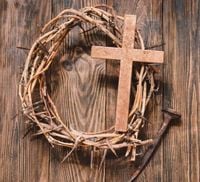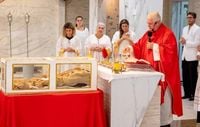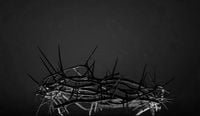Good Friday, also known as Sexta-feira da Paixão, is one of the most significant moments within the Catholic liturgical calendar, marking the second day of the Paschal Triduum. This solemn day is characterized by deep introspection and reverence as the faithful recall the Passion and death of Jesus Christ. Unlike other days, Good Friday is not celebrated with the traditional Mass; instead, it features a special liturgy that highlights the sacrifice of Christ.
Celebrated on April 18, 2025, Good Friday is a day when the Catholic Church refrains from holding Holy Mass, replacing it with a silent liturgy centered on the Celebration of the Passion of the Lord, which occurs at 3 PM—the symbolic hour of Jesus' death. According to Father Paulo Vital, the parish priest of the Santuário Nossa Senhora da Abadia, this moment is the supreme act of love and sacrifice, where “Jesus redimes and rescues the world for God, taking upon himself all the pains of humanity to deliver us His divine life.”
The altar during this liturgy remains bare, devoid of cloth, flowers, or candles, symbolizing mourning and silence before the death of the Savior. This absence of the celebration of Mass is a unique characteristic of Good Friday, underscoring the solemnity and mourning associated with the crucifixion of Jesus.
Good Friday is part of the Paschal Triduum, which begins on Holy Thursday with the Mass of the Lord's Supper and extends until Easter Sunday. It serves as a profound invitation for the faithful to immerse themselves in the central mystery of the Christian faith: the passion, death, and resurrection of Jesus Christ. “During these three days, the Church enters into a single liturgical and spiritual movement. The rite is the same in all parishes around the world. No matter where the faithful are, they will find the same message and gestures: the Supper, the Cross, and the Light of the Resurrection,” explains Father Paulo.
On this day, the faithful listen to the reading of the Passion according to Saint John, participate in the universal prayers—interceding for all humanity—and engage in the Adoration of the Cross, a profound gesture of reverence and gratitude for Christ's sacrifice. The liturgical elements of Good Friday are rich in symbolism, beginning with the priest entering in silence and prostrating himself in a sign of mourning and penance.
One of the most solemn moments in the liturgy is the Universal Prayer, where prayers are offered for the needs of the whole world, reflecting the comprehensiveness of Christ’s sacrifice. Another central element is the Adoration of the Cross, where the faithful venerate the cross, recognizing it as a symbol of Jesus’ ultimate sacrifice. This act is not an adoration of the object itself but of what it represents: the total surrender of Christ for humanity.
In Brazil, Good Friday is an official holiday, as established by Law 9.093/1995, rooted in the country’s colonial past when Christianity was the official religion of the Empire. “Although Brazil is a secular state, it has been agreed that this calendar would be maintained as a holiday because it is part of the culture, tradition, and customs of the people,” explains theologian Ana Beatriz Dias Pinto.
The preparation for Easter, which is also closely tied to Good Friday, dates back to traditions prior to Christianity, practiced in Judaism. Jewish texts relate the celebration of Pessach on the Saturday and Sunday of the full moon after the beginning of spring in the northern hemisphere. Ana Beatriz notes that Jesus’ death was anticipated to a Friday to avoid coinciding with Jewish festival rituals, stating, “When Jesus was sentenced to death, they needed to advance the moment of his crucifixion to not interfere with the festivities of the Jews.”
In the Jewish tradition, the sacrifice of a lamb marked the protection of homes during the tenth plague of Egypt. This sacrificial act was reinterpreted in Christianity as a foreshadowing of Jesus’ crucifixion. “The theological interpretation of this event is grounded in the gospels, particularly the Gospel of John and the letters of Saint Paul, where he states that Christ was the true Passover and was sacrificed,” explains Ana Beatriz.
Good Friday is also a time of fasting and abstinence, reinforcing the penitential and reflective character of the day. The absence of the Eucharistic celebration is a sign of mourning. Father José Ulisses Leva from the Capela Sion in São Paulo explains that the restriction on consuming red meat during this preparation is significant: “The Solemnity of Easter is fundamental for Christians. In the Catholic Church, it is restricted not to eat red meat on Ash Wednesday and Good Friday because red meat recalls the body of Jesus Christ.”
Nutritionist Maria Clara Santana emphasizes that abstaining from red meat on these days does not harm health, suggesting alternatives like chicken and fish, which provide similar nutrients. “In nutritional terms, there is no harm from this abstinence, as it is a specific time where we can substitute red meat with other protein sources,” she explains.
As the day progresses, many parishes hold the traditional Procession of the Dead Lord, a gesture of popular piety expressing the community’s sorrow over Christ’s death. This day is marked by silence, with no bells or musical instruments, inviting a spirit of reflection, fasting, and prayer.
Good Friday, thus, serves as the apex of liturgical silence and sacrificial love—a pause in time to remember that from the deepest pain, the salvation of the world emerged. It is an opportunity for believers to reflect on their lives, renew their faith, and prepare their hearts for the joy of the Resurrection that will be celebrated on Easter Sunday.








